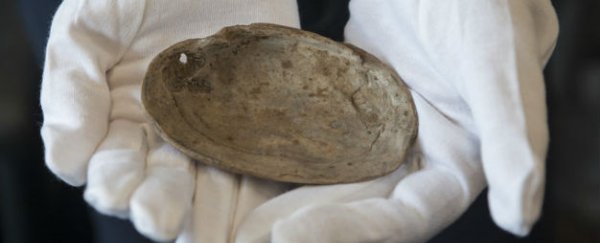An international team of scientists has discovered what they think is the earliest known example of deliberate patterns made by ancient humans. Found on the Indonesian island of Java, the zig-zag patterned shell has been carbon-dated to as far back as 540,000 years ago, which discounts the possibility that it was made by either Neanderthals or modern humans.
This find is at least four times older than what was previously the oldest known etched artefact - geometric carvings in a sample of ochre found in South Africa's Blombos Cave. This means the carvings would have had to have been made by our pre-Neandethal ancestor, Homo erectus, and pushes the origin of engraving behaviour back by at least 300,000 years.
"It rewrites human history," Stephen Munro from School of Archaeology and Anthropology at the Australian National University in Canberra said in an emailed press release. "This is the first time we have found evidence for Homo erectus behaving this way. It puts these large bivalve shells and the tools used to engrave them, into the hands of Homo erectus, and will change the way we think about this early human species."
The etched and fossilised mussel shell was actually discovered way back in the 19th Century, by the man who discovered Homo erectus - Dutch palaeontologist Eugene Dubois - but only now have scientists noticed the patterns. The shell is being housed with a handful of others at a museum in the Netherlands, where Dubois first deposited them for safe-keeping.
About seven years ago, archaeologist Josephine Joordens of Leiden University in the Netherlands took an interest in the collection when she was trying to reconstruct what the environment would have looked like for our ancient ancestors living in Indonesia at the time. "Was it a river? Was the sea very close? Was it a lake? In that context I started looking at the shells from the collection," she told Nell Greenfieldboyce at NPR.
Her Australian colleague, Munro, took a photo of the shells, and only recently, when he was looking back at them, did he see the etchings. "He sent me an email with a photo attached, and he said, 'Well, Josie, what do you think? What are we looking at here?' And we looked at it and we thought, well, it's kind of strange," Joordens told Greenfieldboyce.
"It was a eureka moment. I could see immediately that they were man-made engravings. There was no other explanation," Munro says in the press release.
The team, which includes researchers from several different universities around the world, reports in Nature today that the shells found alongside this particular zig-zagged shell displayed further evidence of tool use by Homo erectus to alter them in useful ways. Some of the shells had holes 'drilled' into them by a shark's tooth, right where the muscle was originally attached. This means the ancient humans knew where and how to damage the sea creature so the clamped-up shell would pop open.
Another shell looked like it had been sharpened into a tool for slicing or scraping.
The team has been careful not to make any assumptions about what the engraving could mean, or what kind of ancient human could have made it, and for what purpose. Archaeologist Wil Roebroeks, also from Leiden University, told AFP, "We have no clue why somebody made it half a million years ago, and we explicitly refrain from speculating on it."
Alison Brooks, a paleoanthropologist at George Washington University in the US, who was not involved in the study, has taken a more skeptical view of the find, suggesting to NPR that the markings were perhaps not as deliberate as we might think - perhaps they're just the earliest 'doodles' made by an ancient human child, she said.
 Wim Lustenhouwer / VU University Amsterdam
Wim Lustenhouwer / VU University Amsterdam
Sources: NPR, Phys.org, The Australian National University (emailed)
